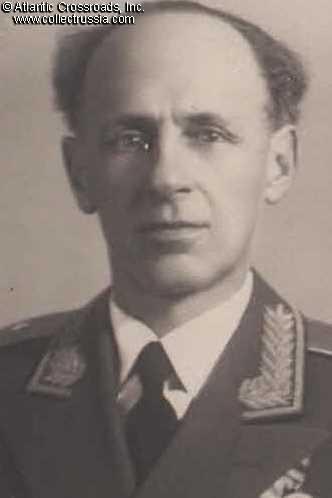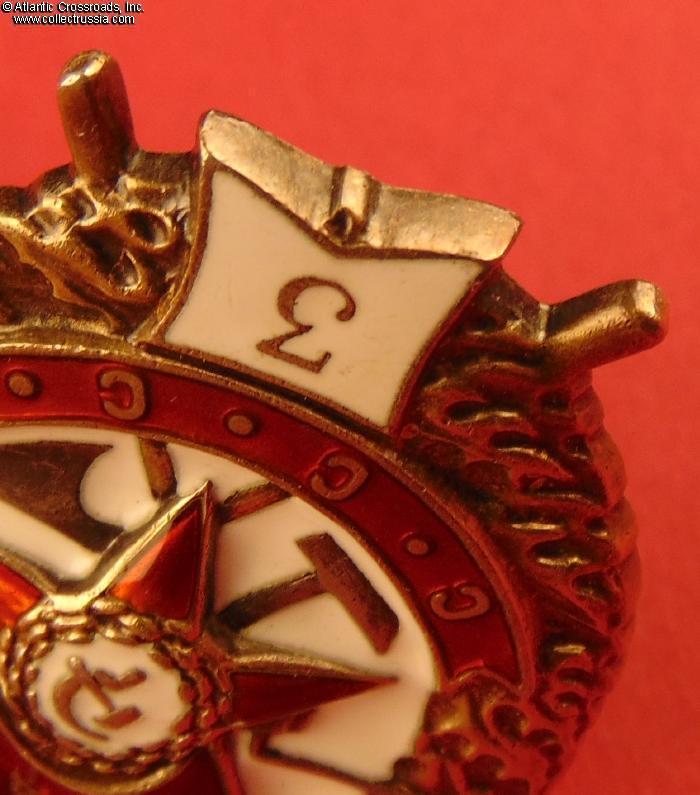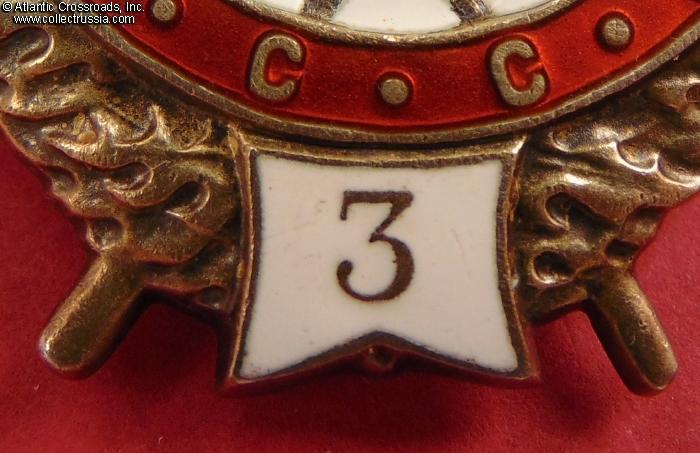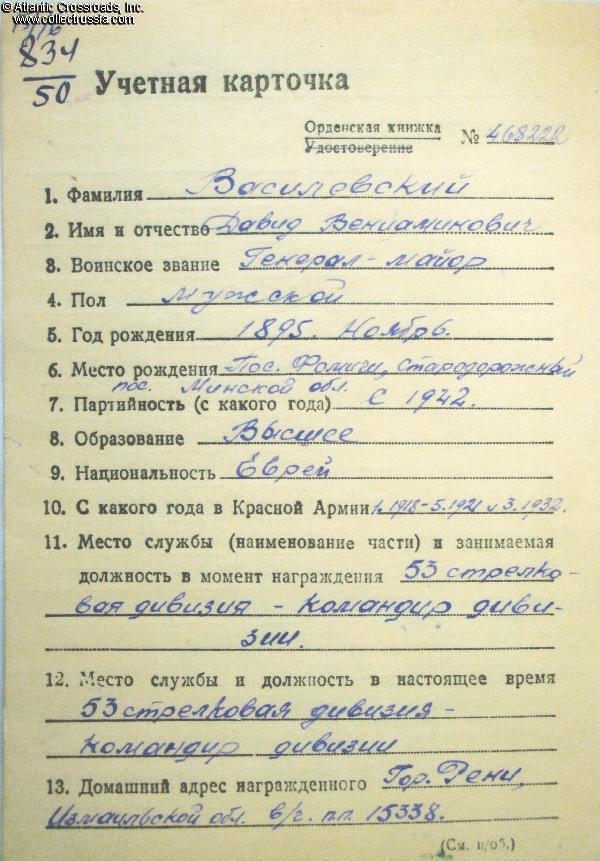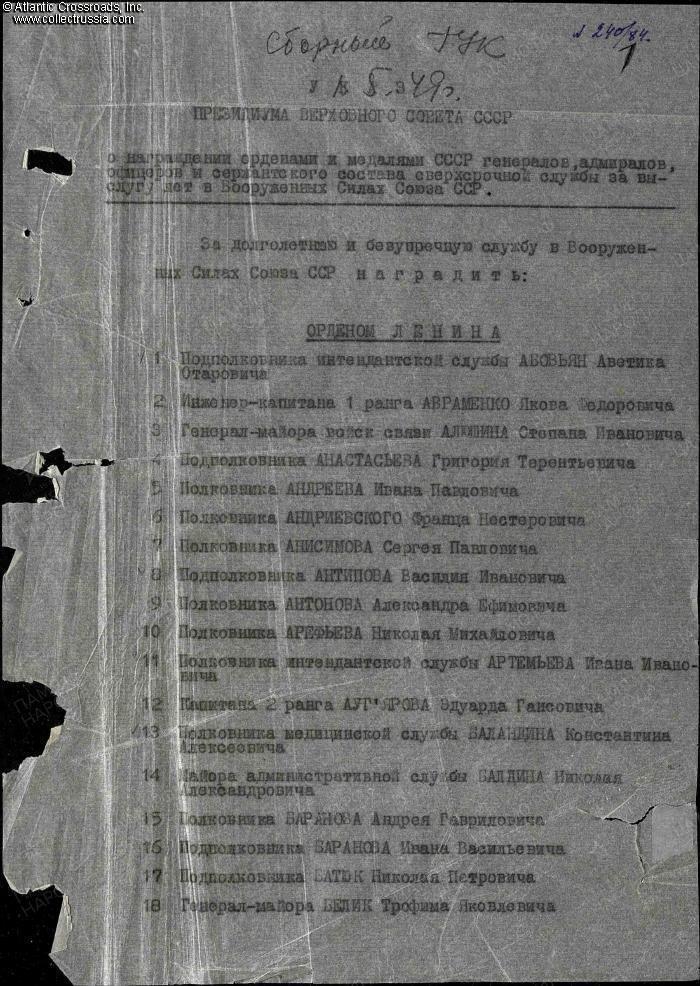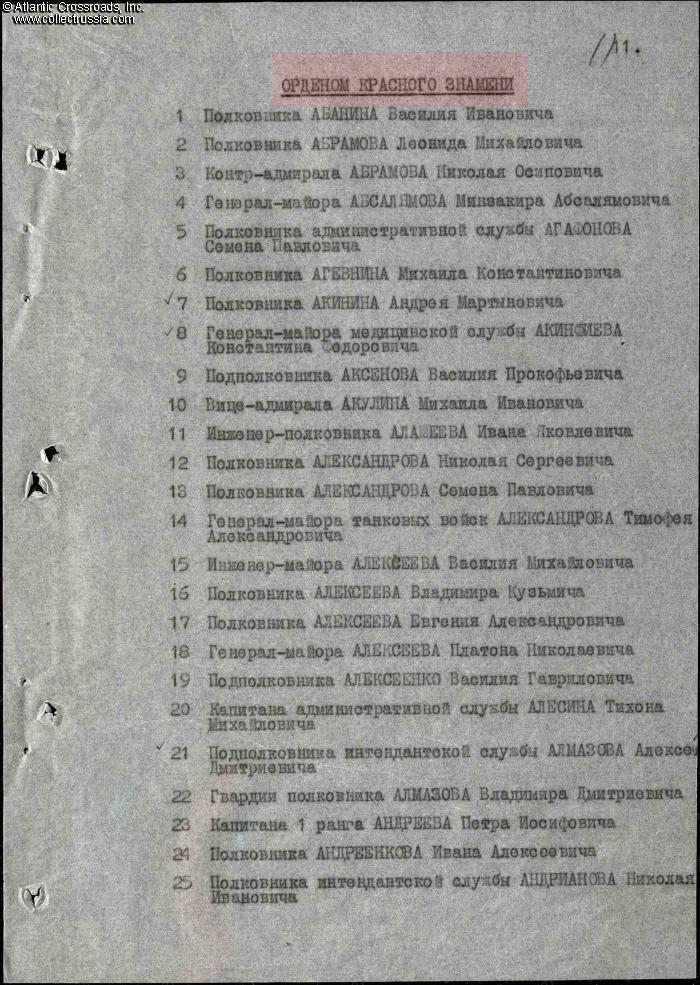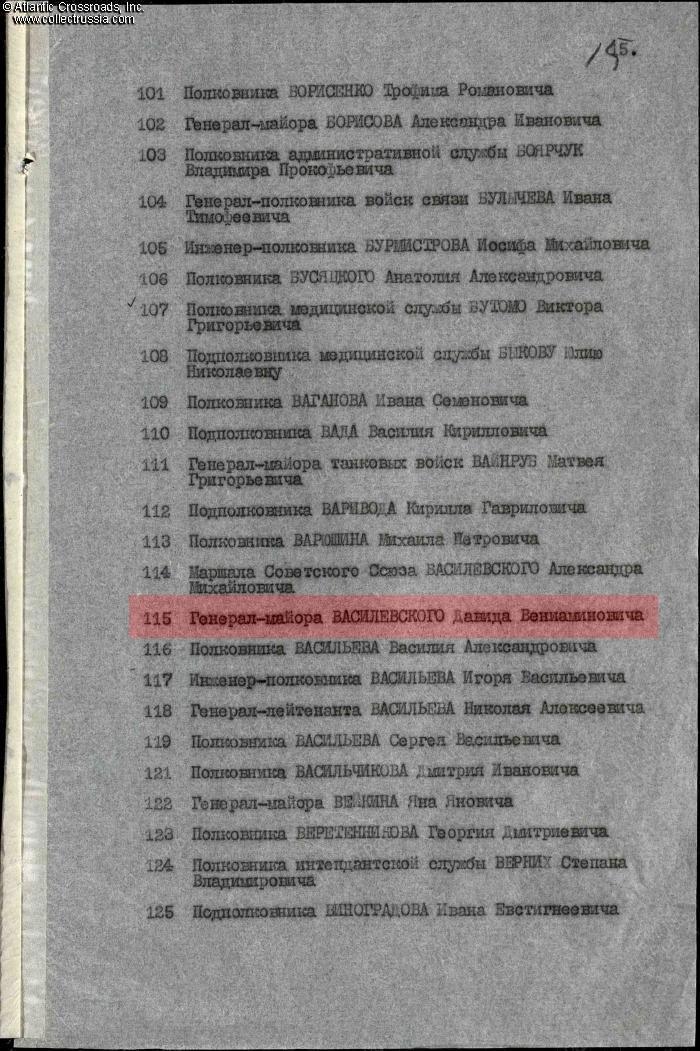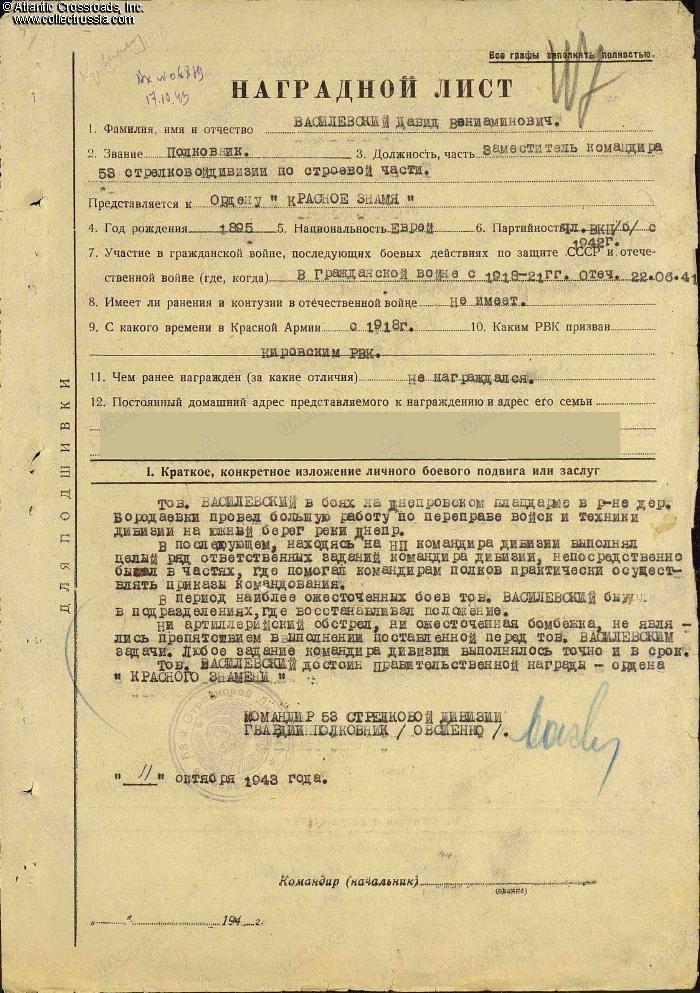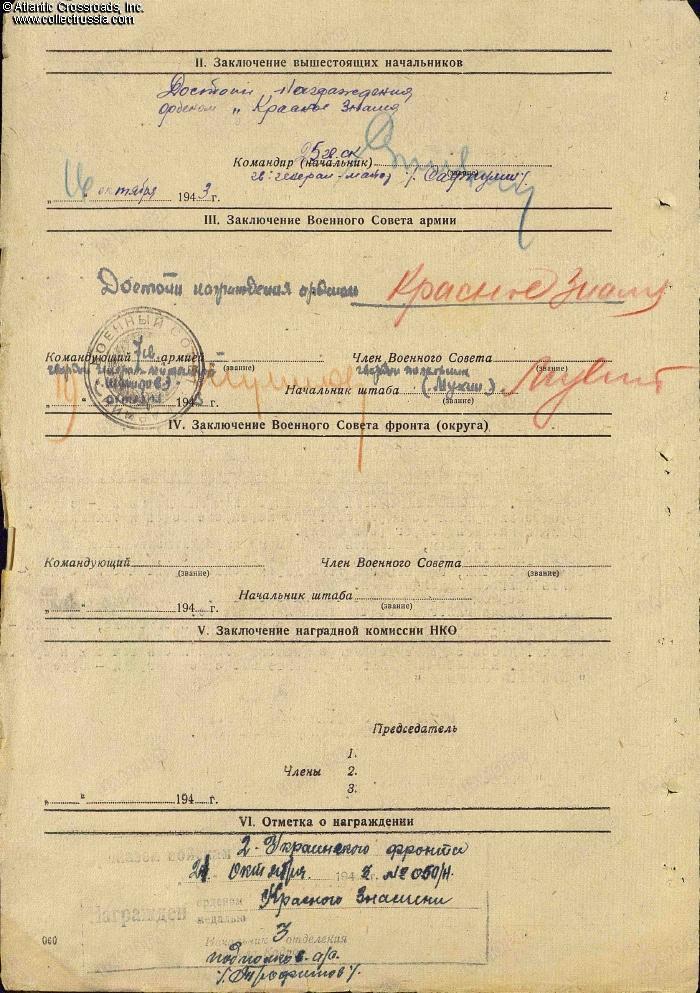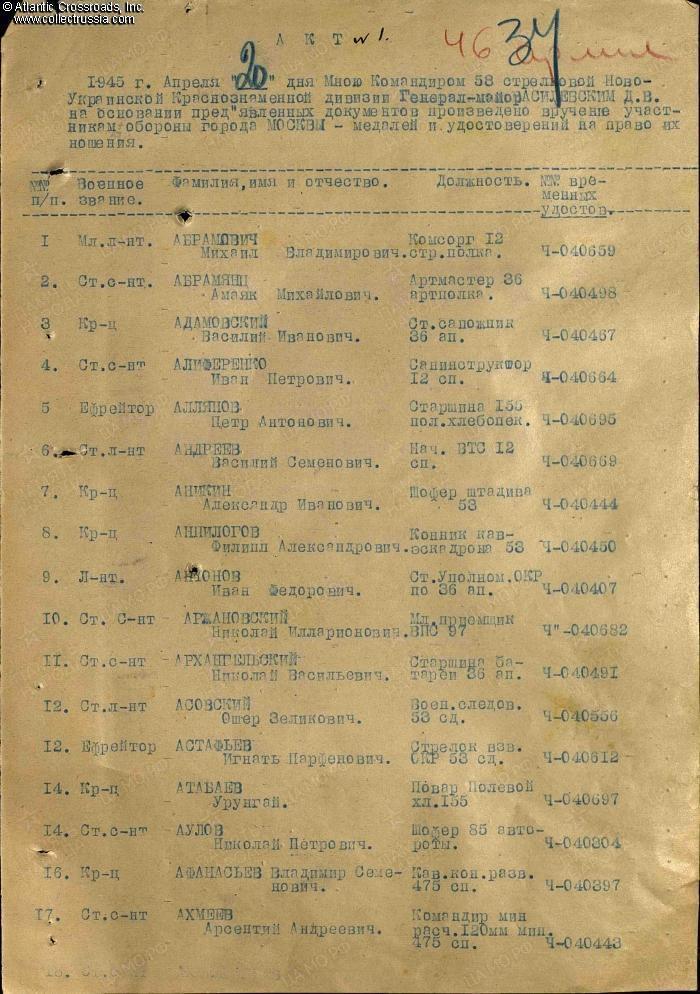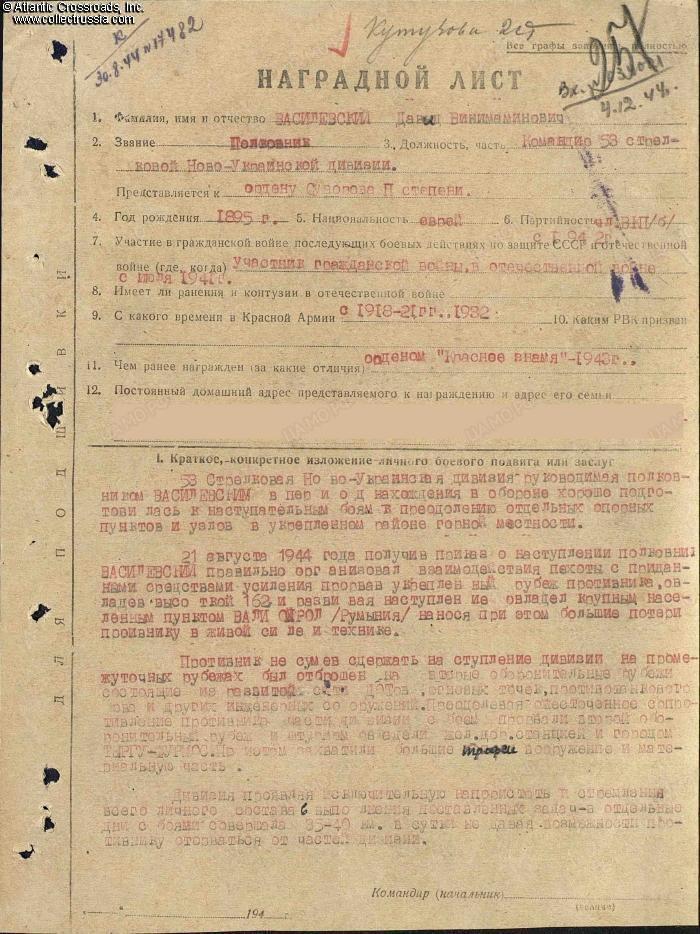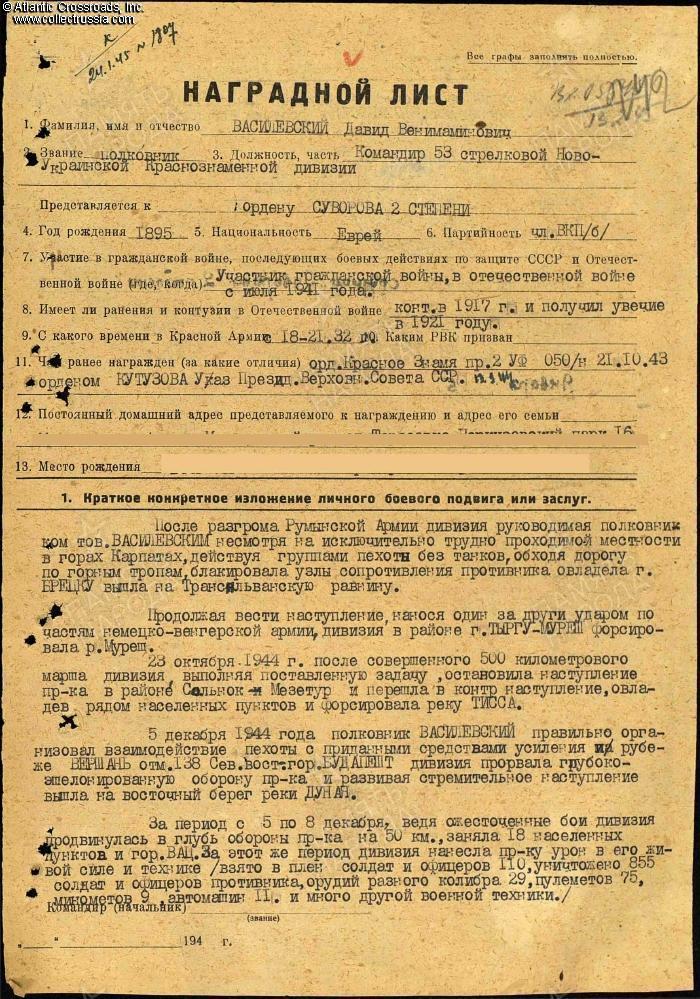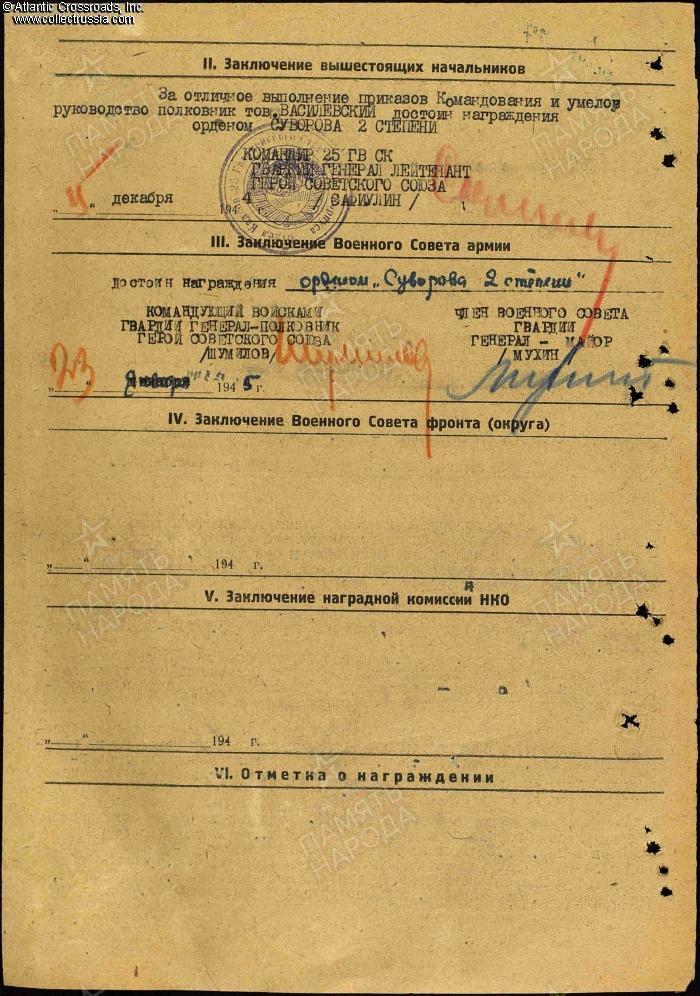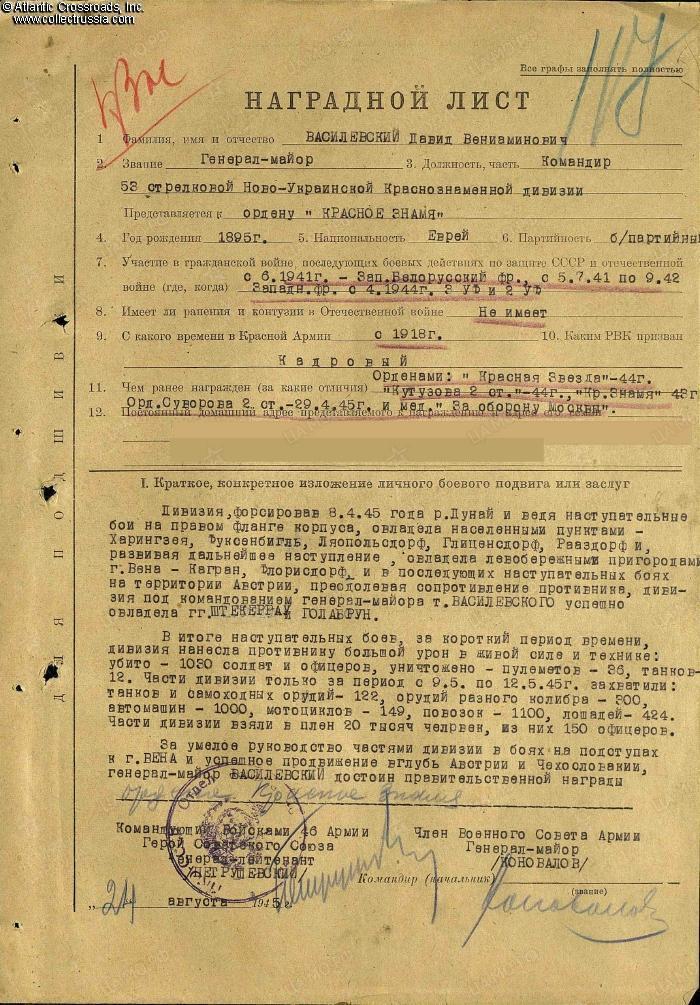
Order of the Red Banner, 3rd Award, Type 4 Variation 2, Sub-Variation 5, #5237, awarded on 20 June 1949 to Major General David Vasilevsky, Commander of the 53rd Rifle Division.
Silver gilt, enamels; measures 45.8 mm in height including the eyelet, 37.2 mm in width; weighs 24.8 g, not including the suspension and connecting link. The obverse features five flames in the torch, three of them in the lower row and two stacked above on top of each other. The mint mark is stamped on the reverse in a relatively large font in a single curved up line. There is a distinct star-shaped depression in the center of the reverse.
Manufactured at the Moscow Mint in 1949, this piece is from a small series of slightly over 1300 specimens. According to The Order of
Silver gilt, enamels; measures 45.8 mm in height including the eyelet, 37.2 mm in width; weighs 24.8 g, not including the suspension and connecting link. The obverse features five flames in the torch, three of them in the lower row and two stacked above on top of each other. The mint mark is stamped on the reverse in a relatively large font in a single curved up line. There is a distinct star-shaped depression in the center of the reverse.
Manufactured at the Moscow Mint in 1949, this piece is from a small series of slightly over 1300 specimens. According to The Order of the Red Banner by Durov and Strekalov, the serial number range for this sub-variation is from 4401 - 5733. Moreover, only a part of the Red Banners in the series had this particular type of mint mark /The Order of the Red Banner, pp. 156, 157/.
In outstanding, excellent condition. The enamel is literally pristine: it is free of even the microscopic contact marks that could be found under a 10x magnification and retains a magnificent luster. The raised details of the wreath, torch and flagpole are perfect and crisp; the gold plating is intact and bright throughout. There is similarly attractive even toning to the reverse.
Comes on a late-1940s suspension device, a two-layer model in steel with an integral catch of the pin. The old ribbon is well-preserved. with immaculately preserved old ribbon. The connecting link has been cut but appears to be of the period. Overall, a superb piece, practically impossible to upgrade.
David Vasilevsky (Давид Вениаминович Василевский) was born in 1895 to a Jewish family in a Belorussian village in Minsk Province, then part of the Russian Empire. After finishing the Minsk Commercial School in 1913, he joined the Russian Imperial Army as a volunteer and was sent to the 158th Infantry Regiment. His stint in the Imperial Army was rather convoluted, including desertion and a year of hiding on forged documents, return to the Army in 1916, a year of studies at a military engineering school in Kiev, and appointment as head of communications of the 190th Infantry Regiment in April 1917. There, he was elected chairman of the soldiers' committee which, one might say, determined all of his subsequent military career.
After arriving from the front in January 1918, Vasilevsky was appointed head of a Red Guard detachment and was sent to suppress and liquidate two anti-Soviet uprisings. Armed with that experience, Vasilevsky's detachment was transferred to the Eastern Front to fight the White Czechs (former WWI prisoners who had volunteered to fight on the Russian side and subsequently rebelled against Bolshevik attempts to disarm them), followed by transfer to Lithuania in 1919 where he continued to liquidate the "counter-revolutionary elements." Having proved his loyalty to the Soviet regime, Vasilevsky was appointed military commissar of the 29th Rifle Regiment. In the post-war period, he served in the People's Commissariat of Food of the Belorussian SSR in the procurement department. Ironically but not uncommonly, he got so comfortable with procuring that the tribunal of the republic sentenced him to three years of prison for "illegal confiscation of grain." Belonging to the military political elite worked its magic: the sentence was first suspended, shortly thereafter canceled, and Vasilevsky returned to work in procurement. It also helped in making a spectacular career in Accounting and Planning of economy in socialist Belorussia.
In March 1930, he rejoined the Red Army and was assigned to the 10th Rifle Regiment, 4th Rifle Division, Belorussian Military District, as chief of communications. Stalin's Great Purge of 1937 left Vasilevsky relatively unscathed. He was dismissed from the army, arrested by the NKVD, spent 15 months in prison under investigation, and was released for lack of corpus delicti. In March 1939, he was reinstated in the cadres of the Red Army. At the beginning of the Patriotic War, Vasilevsky was in the rank of Major. His 209th Motorized Division of the 17th Mechanized Corps participated in the battles at the frontiers and fought its way back east to the Mogilev Region. There, he was out in charge of the newly formed 206th Reserve Rifle Regiment and fought with it as a part of the Western Front (army group). He participated in the Battle of Moscow and in the battles in the encirclement near Vyazma. In September 1942, he was appointed Deputy Commander of the 53rd Rifle Division, 33rd Army, Western Front. The division's path included many transfers and re-subordinations. It fought along the Kaluga- Vyazma railway, the Izyum bridgehead, Kharkov Region. With the 25th Guards Rifle Corps of the 7th Guards Army, it crossed the Dnieper near the village of Novy Orlik in late September 1943.
In December 1943 - January 1944, Vasilevsky, now in the rank of Colonel, temporarily commanded the division due to the commander's departure for treatment, then returned to his regular duties in Communications but on 15 April 1944, he took command of the division and fought in this position until the end of the war. With the 7th Guards Army, he took part in the Yassy-Kishinev offensive. For the capture of the city of Iasi, the division was awarded the Order of the Red Banner. Following that was participation in the Budapest offensive, capture of the towns of Abony and Vac and advance to the Danube north of Budapest. By 10 January 1945, the division approached the town of Komarno in Slovakia and fought hard battles against large enemy forces. On 13 March, it was withdrawn to the reserve of the 2nd Ukrainian Front, then got assigned to the 46th Army and participated in the Vienna offensive. By 15 April, the encirclement of the enemy grouping which was trying to retreat to the city of Vienna, was completed. On 11 May, the units of the division met with the allied American troops on the Kaplice- Freistadt line in southern Czechia.
In September 1946, then already a Major General, Vasilevsky was appointed as an instructor of tactics of the Vystrel officer training program and, a month later, became the head of its editorial and publishing department. On 8 January 1958, he was discharged from active service due to an illness. He died in Kiev in 1976 at the age of 80.
Vasilevsky received several high decorations for his military service in WW2. Chronologically, the first was the Order of the Red Banner (#75101) in October 1943 for successful forced crossing of the Dnieper. In September 1944, he received the Order of Kutuzov 2nd cl. (#1291) for success in the Yassy-Kishinev offensive, a major push through Moldavia into Romania which ended in destroying the German 6th Army (that had been reconstituted after Stalingrad), securing crucial oil fields, and forcing Romania to switch sides in the war. Next came the Order of the Red Star awarded in November 1944 for length of service. His fourth decoration, the Order of Suvorov 2nd cl. (#1961), was awarded in April 1945 for success in the Battle of Budapest. The last wartime award was the Order of the Red Banner (#229785) received in September 1945 for excellent leadership during the Vienna offensive. After the war, Vasilevsky received two more decorations for length of service: the Order of the Red Banner, 3rd Award in June 1949 and the Order of Lenin (#262751) in November 1954. Note that the chronological order of these two awards is reversed. The Decree of the Presidium of the Supreme Soviet of the USSR of 4 June 1944, which instituted the practice of awarding military orders and medals for length of service, established that the Order of Lenin be awarded for 25 years of service while the second Order of the Red Banner - for 30 years.
Research Materials: b/w photocopy of the award card; award commendations for all WW2 combat decorations; relevant part of the award
decree for the Order of the Red Banner, 3rd Award. The facts of Vasilevsky's biography can be found on the Russian archival website pamyat-
naroda.ru.
$2,850.00 Add to cart



